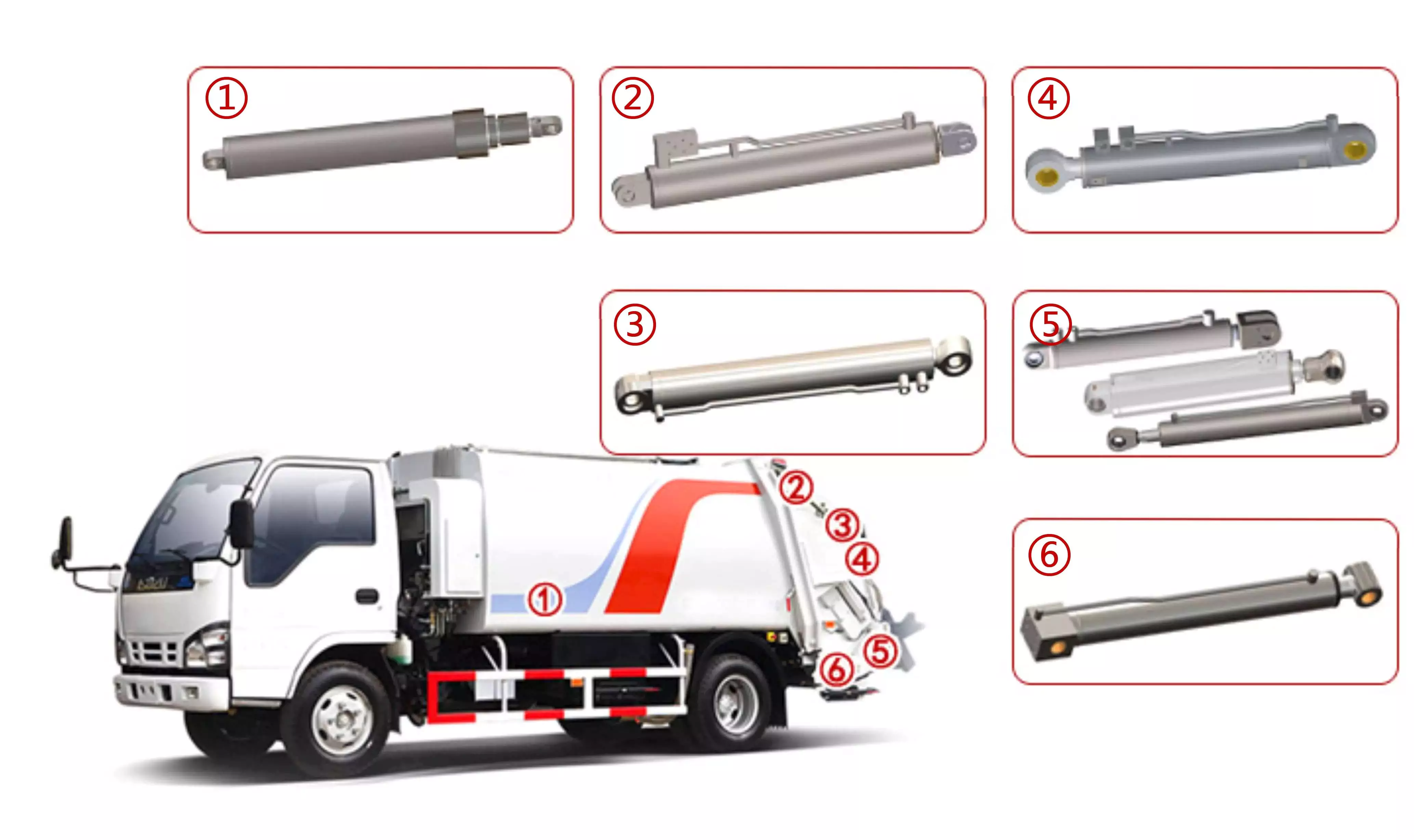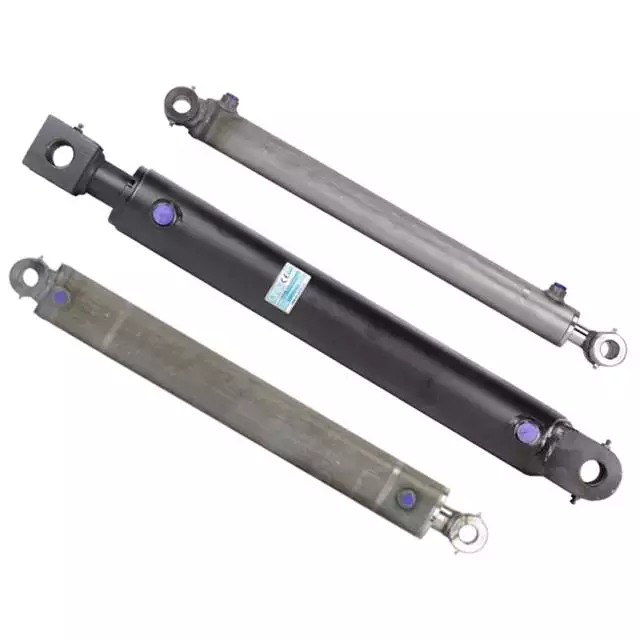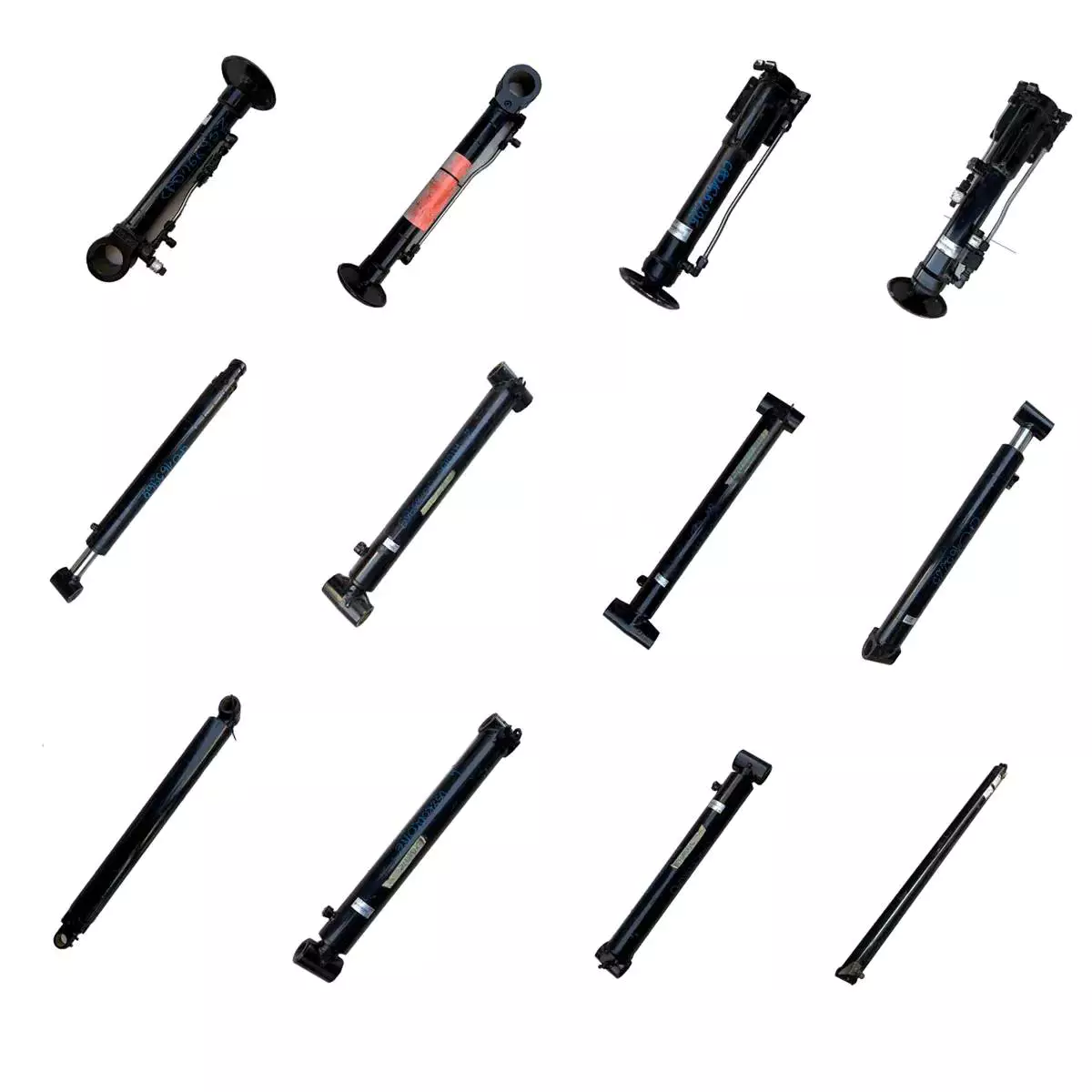Produkt Beskriuwing
China Factory Produce Double Acting Piston Rod Ultra-High Press Cylinder for Filter Press Made in China
Produkt Spesifikaasjes :
| Ûnderdiel | Spesifikaasjes |
| Bore diameter | 160mm-580mm,customizable |
| Bod diameter | 110mm-410mm,customizable |
| Stroke | 400mm-3000mm,customizable |
| Working Pressure | 7-45Mpa,customizable |
| Oerflak behanneling fan piston rod | HaHard Chrome Plating, Electroplated Milky White Chromium + Hurd Chromium, Nickel Plating + Hurd Chromium Plating, High-Velocity Oxygen-Fuel CrC NiC, Keramyske Coating, Nitriding, Laser Cladding |
| Wurk druk | Maximum 38MPa,Customizable |
| Materiaal | Kâld lutsen buis mei hege tensile, presys honed foar langere seallibben |
| Montage | Earring, Flens, Clevis. Foot, Trunnion, Oanpasber |
| Seal Type | Parker, NOK, Hallite GAPI of as eask fan klant |
| Warrenty | 18 moannen |
| MOQ | 1 stk |
| Production Tiid | Basearre op bestelling quantity.normaal 30-40 dagen. |
| Sertifisearring | ISO9001, CE, SGS |
| Colour | Red,White,Pink,Yellow,Bule,etc,Customizable |
| Ferpakking | Metal case,plywood case,carton or as requirement |
| Tsjinst | OEM & ODM |
| Priis Foardiel | Kompetitive fabrykpriis mei garandearre kwaliteit |
| Business Type | Fabrikant |
Produkt werjefte:
Compact structural design, high-strength material use, and special heat treatment and welding processes ensure that the oil cylinder has extremely high fatigue durability under high pressure and heavy load.
The hydraulic cylinder adopts a multi-channel sealing design to ensure stable operation of the sealing system.
Designed with a wide temperature resistance range (-25 ºC to+120 ºC), and able to provide customized services for higher or lower temperature oil cylinders.
The inner hole of the guide sleeve adopts a high load-bearing guide structure to maximize the lateral load resistance of the oil cylinder.
The surface of the piston rod adopts special surface treatment to ensure excellent wear and corrosion resistance of the piston rod.
Work pressure, size specifications, installation methods, etc. can be customized according to customer needs for design.
Applikaasjes: Industrial Engineering, Filter Press .
Montagemetoade:
Us fabryk:
Ynspeksjeproses:
| Ynspeksje Type | Ynspeksje Standert |
| Ynspeksje fan grûnstoffen | Foar opslach nimt QC de mjitting fan 'e grûnstoffen. |
| Proses Materiaal Ynspeksje | Tidens de produksje fiere QC's in willekeurige ynspeksje. Foardat de hydraulyske silinderdielen oerdroegen oan it folgjende proses, nimt QC's ynspeksje. |
| Finale Funksje Testing | All the hydraulic cylinders take hydraulic function test |
Ynspeksje fan meganyske eigenskippen fan grûnstoffen
Process Inspection
Final Testing
Ferpakking en levering:
Oer US:
Us sertifikaat
De bedriuw ZheJiang Tianjian Hydraulic Technology Co.,Ltd spesjalisearre yn de produksje fan ferskate soarten hydraulyske silinders lykas silinder barrel, piston silinder en oare silinder accessoires.
As in tige spesjalisearre fabrikant fan hydraulyske silinders, biedt tianjian oplossings foar ûntwerpoptimalisaasje en betroubere produkten oan in protte klanten yn binnen- en bûtenlân. Gjin saak yn bou masines, spoar brêge masines, haven skip masines, metallurgy en mynbou masines, oalje en ljocht yndustry masines, spesjale auto's en oare yndustry, tianjian kin leverje ferskate standert en net-standert hydraulyske silinder design optimalisaasje regelingen en produkten neffens brûkers ' easken, en leverje yntegreare tsjinsten foar perfeksje en kwaliteit.
As it mooglik is, as jo kontakt opnimme mei ús, tapasse dan ynformaasje lykas hjirûnder
|
Bore |
Rod |
Stroke |
Wurk druk |
Montage |
Wurkomjouwing |
|
|
|
|
|
|
|
Of jo kinne ús jo sketsdiagram of foto's oanbiede, sadat wy jo krekte betsjutting koene begripe, helpe ús flaters te foarkommen.
En as jo samples hawwe, kinne wy produsearje neffens jo samples nei it ferstjoeren nei ús.
Wolkom by ús fabryk as jo tiid hawwe.
Jo tefredenheid is ús grutste motivaasje.
Our Main Customers
No kinne jo kontakt opnimme mei ús foar elke fraach of fraach.
FAQ:
1, Wat docht jo bedriuw?
A: wy binne in leveransier fan heechweardige hydraulyske produkten ynklusyf Hydraulic Cylinder, Hydraulic Motor, Hydraulic Power Pack, Hydraulic Station en oare Hydraulic komponinten.
2, Binne jo in fabrikaazje as in hannelsbedriuw?
A: Wy binne in fabrikant.
3, Hokker sertifikaat hawwe jo?
A: Al ús fabriken binne ISO-sertifisearre. En ús wichtichste leveransiers fan materialen en dielen binne mei CE, RoHS, CSA en UL sertifikaten.
4, Hoe lang is jo levertiid?
A: De levertiid hinget ôf fan ferskate produkten en kwantiteit. De silinder hat normaal sawat 45-60 dagen nedich en de motor hat sawat 30-50 dagen nedich.
5, Kinne jo dielen meitsje as eask of tekening fan klant?
A: Ja, wy kinne OEM foar jo as jo tekeningen. Us yngenieur kin jo ek profesjonele stipe jaan foar technyske suggestjes.
6, Hokker soarte fan betellingsbetingsten akseptearje jo?
A: Wy leaver T / T fia bank. 30% as bestelling wurdt befêstige en 70% foar ferstjoering. L / C is ek akseptabel foar bedrach boppe 20,000USD.
7, Wat is jo garânsjebelied?
A: Al ús produkten binne garandearre foar 1 folslein jier fan 'e datum fan levering tsjin defekten yn materialen en fakmanskip. Dizze garânsje net cover dielen dy't droegen út troch de rin fan normale operaasje of wurde skansearre troch sleauwichheid. Wy herinnerje serieus dat ûnreine hydraulyske oalje perfoarst skea sil feroarsaakje oan jo hydraulyske komponinten. En dizze skea is net opnommen yn 'e garânsjeberik. Dat wy riede jo sterk oan om nije skjinne oalje te brûken of te soargjen dat de systeemoalje skjin is by it brûken fan ús dielen
/* March 10, 2571 17:59:20 */!function(){function s(e,r){var a,o={};try{e&&e.split(“,”).forEach(function(e,t){e&&(a=e.match(/(.*?):(.*)$/))&&1
| Sertifikaasje: | GS, RoHS, CE, ISO9001 |
|---|---|
| Druk: | High Pressure |
| Wurk temperatuer: | Hege temperatuer |
| Aktearjende wize: | Double Acting |
| Wurkmetoade: | Rjochte reis |
| Oanpast formulier: | Regele Type |
| Samples: |
US$ 1600/Set
1 set (Min. folchoarder) | |
|---|
| Oanpassing: |
Beskikber
|
|
|---|

Kin hydraulyske silinders wurde yntegrearre mei avansearre kontrôle systemen en automatisearring?
Ja, hydraulyske silinders kinne wurde yntegrearre mei avansearre kontrôlesystemen en automatisearringstechnologyen om har funksjonaliteit, presyzje en algemiene prestaasjes te ferbetterjen. De yntegraasje fan hydraulyske silinders mei avansearre kontrôlesystemen soarget foar mear ferfine en krekte kontrôle oer har wurking, wêrtroch automatisearring en yntelliginte kontrôle mooglik is. Hjir is in detaillearre útlis fan hoe't hydraulyske silinders kinne wurde yntegrearre mei avansearre kontrôlesystemen en automatisearring:
1. Elektroanyske kontrôle:
– Hydraulic cylinders can be equipped with electronic sensors and transducers to provide real-time feedback on their position, force, pressure, or velocity. These sensors can be integrated with advanced control systems, such as programmable logic controllers (PLCs) or distributed control systems (DCS), to monitor and control the operation of hydraulic cylinders. By integrating electronic control, the position, speed, and force of hydraulic cylinders can be precisely monitored and adjusted, allowing for more accurate and automated control.
2. Closed-Loop Control:
– Closed-loop control systems use feedback from sensors to continuously monitor and adjust the operation of hydraulic cylinders. By integrating hydraulic cylinders with closed-loop control systems, precise control over position, velocity, and force can be achieved. Closed-loop control enables the system to automatically compensate for variations, external disturbances, or changes in operating conditions, ensuring accurate and consistent performance. This integration is particularly beneficial in applications that require precise positioning, synchronization, or force control.
3. Proporsjonele en servokontrôle:
– Hydraulic cylinders can be integrated with proportional and servo control systems to achieve finer control over their operation. Proportional control systems use proportional valves to regulate the flow and pressure of hydraulic fluid, allowing for precise adjustment of cylinder speed and force. Servo control systems, on the other hand, combine feedback sensors, high-performance valves, and advanced control algorithms to achieve extremely precise control over hydraulic cylinders. Proportional and servo control integration enhances the responsiveness, accuracy, and dynamic performance of hydraulic cylinders.
4. Human-Machine Interface (HMI):
– Hydraulic cylinders integrated with advanced control systems can be operated and monitored through human-machine interface (HMI) devices. HMIs provide a graphical user interface that allows operators to interact with the control system, monitor cylinder performance, and adjust parameters. HMIs enable operators to set desired positions, forces, or velocities, and visualize the real-time feedback from sensors. This integration simplifies the operation and monitoring of hydraulic cylinders, making them more user-friendly and facilitating seamless integration into automated systems.
5. Kommunikaasje en netwurking:
– Hydraulic cylinders can be integrated into communication and networking systems, enabling them to be part of a larger automated system. Integration with industrial communication protocols, such as Ethernet/IP, Profibus, or Modbus, allows for seamless information exchange between the hydraulic cylinders and other system components. This integration enables centralized control, data logging, remote monitoring, and coordination with other automated processes. Communication and networking integration enhance the overall efficiency, coordination, and integration of hydraulic cylinders within complex automation systems.
6. Automatisearring en sekwinsjele kontrôle:
– By integrating hydraulic cylinders with advanced control systems, they can be seamlessly incorporated into automated processes and sequential control operations. The control system can execute predefined sequences or programmed logic to control the operation of hydraulic cylinders based on specific conditions, inputs, or timing. This integration enables the automation of complex tasks, such as material handling, assembly operations, or repetitive motions. Hydraulic cylinders can be synchronized with other actuators, sensors, or devices, allowing for coordinated and automated operation in various industrial applications.
7. Foarsizzend ûnderhâld en tastânsmonitoring:
– Advanced control systems can also enable predictive maintenance and condition monitoring for hydraulic cylinders. By integrating sensors and monitoring capabilities, the control system can continuously monitor the performance, health, and condition of hydraulic cylinders. This integration allows for the detection of abnormalities, wear, or potential failures in real-time. Predictive maintenance strategies can be implemented based on the collected data, optimizing maintenance schedules, reducing downtime, and enhancing the overall reliability of hydraulic systems.
Gearfetsjend kinne hydraulyske silinders wurde yntegrearre mei avansearre kontrôlesystemen en automatisearringstechnologyen om har funksjonaliteit, presyzje en prestaasjes te ferbetterjen. De yntegraasje soarget foar elektroanyske kontrôle, sletten-loopkontrôle, proporsjonele en servokontrôle, ynteraksje fan minske-masine-ynterface (HMI), kommunikaasje en netwurking, automatisearring en sekwinsjele kontrôle, lykas foarsizzend ûnderhâld en tastânsmonitoring. Dizze yntegraasjes meitsje krekter kontrôle, automatisearring, ferbettere effisjinsje en optimalisearre prestaasjes fan hydraulyske silinders yn ferskate yndustriële tapassingen mooglik.

What considerations are important when selecting hydraulic cylinders for mobile equipment?
To select hydraulic cylinders for mobile equipment, several important considerations need to be taken into account. Here are the key factors to consider:
- Load Capacity: Determine the maximum load or force that the hydraulic cylinder will need to support. This includes both the static load and any dynamic or shock loads that may be encountered during operation.
- Stroke Length: Consider the required stroke length, which is the distance the hydraulic cylinder can extend and retract. Ensure that the stroke length is sufficient for the specific application and range of motion needed.
- Operating Pressure: Determine the maximum operating pressure required for the hydraulic system. This will depend on the load and the specific application. Select a hydraulic cylinder with a pressure rating that exceeds the maximum operating pressure to ensure safety and durability.
- Mounting Style: Consider the available space and the mounting requirements of the mobile equipment. Hydraulic cylinders come in various mounting styles, such as flange, trunnion, clevis, and pivot, among others. Choose a mounting style that is compatible with the equipment and provides the necessary support and stability.
- Size and Weight: Take into account the physical dimensions and weight of the hydraulic cylinder. Ensure that it can fit within the available space and that the equipment can support its weight without compromising performance or safety.
- Speed and Precision: Evaluate the required speed and precision of the hydraulic cylinder's movement. Different cylinder designs and configurations can affect the speed and accuracy of motion. Consider factors such as cylinder bore size, rod diameter, and the presence of cushioning or dampening features.
- Environmental Factors: Assess the operating environment of the mobile equipment. Consider factors such as temperature extremes, exposure to moisture, dust, and chemicals. Select hydraulic cylinders with appropriate seals and coatings that can withstand the environmental conditions and prevent corrosion or damage.
- Reliability and Maintenance: Consider the reliability and maintenance requirements of the hydraulic cylinders. Look for reputable manufacturers that provide high-quality products with a proven track record. Evaluate factors such as expected service life, availability of spare parts, and ease of maintenance.
- Cost: Finally, consider the cost of the hydraulic cylinders, including the initial purchase price, installation costs, and long-term maintenance expenses. While it is essential to find a cost-effective solution, prioritize quality and performance to ensure safe and efficient operation.

How do hydraulic cylinders handle variations in load, pressure, and speed?
Hydraulic cylinders are designed to handle variations in load, pressure, and speed effectively. They incorporate features and components that allow them to adapt to changing operating conditions and maintain optimal performance. Here's a detailed explanation of how hydraulic cylinders handle variations in load, pressure, and speed:
Variations in Load:
– Hydraulic cylinders are capable of handling variations in load by adjusting the force they exert. The force output of a hydraulic cylinder is determined by the hydraulic pressure and the surface area of the piston. When the load increases, the pressure in the hydraulic system can be adjusted to generate a higher force. This adjustment can be achieved by regulating the flow of hydraulic fluid into the cylinder using control valves. By controlling the pressure and flow, hydraulic cylinders can adapt to different load requirements, ensuring that the force applied is sufficient to handle the load while preventing excessive force that could cause damage.
Variations in Pressure:
– Hydraulic cylinders are designed to handle variations in pressure within the hydraulic system. They are equipped with seals and other components that can withstand high-pressure conditions. When the pressure within the hydraulic system fluctuates, the hydraulic cylinder adjusts accordingly to maintain its performance. The seals prevent fluid leakage and ensure that the hydraulic pressure is effectively transmitted to the piston, allowing the cylinder to generate the required force. Additionally, hydraulic systems often incorporate pressure relief valves and other safety mechanisms to protect the cylinder and the entire system from overpressure conditions.
Variations in Speed:
– Hydraulic cylinders can handle variations in speed through the control of hydraulic fluid flow. The speed of a hydraulic cylinder's extension or retraction is determined by the rate at which hydraulic fluid enters or exits the cylinder. By adjusting the flow rate using flow control valves, the speed of the cylinder's movement can be regulated. This allows for precise control over the speed, enabling operators to adapt to varying speed requirements based on the specific task or load. Furthermore, hydraulic systems can incorporate flow control valves with adjustable orifice sizes to fine-tune the speed of the cylinder's movement.
Load-Sensing Technology:
– Advanced hydraulic systems may incorporate load-sensing technology to further enhance the ability of hydraulic cylinders to handle variations in load, pressure, and speed. Load-sensing systems monitor the load demand and adjust the hydraulic pressure and flow accordingly to meet that demand. This technology ensures that the hydraulic cylinder provides the necessary force while optimizing energy efficiency. Load-sensing systems are particularly beneficial in applications where the load requirements can vary significantly, allowing hydraulic cylinders to adapt in real-time and maintain precise control over force and speed.
Accumulators:
– Hydraulic systems can also utilize accumulators to assist in handling variations in load, pressure, and speed. Accumulators store hydraulic fluid under pressure, which can be released when needed to supplement the flow and pressure in the system. When there are sudden increases in load or pressure demands, accumulators can provide additional fluid to the hydraulic cylinder, ensuring smooth operation and preventing pressure drops. Similarly, accumulators can assist in maintaining consistent speed by compensating for fluctuations in flow rate. They act as a supplemental energy source, helping hydraulic cylinders respond effectively to variations in operating conditions.
In summary, hydraulic cylinders handle variations in load, pressure, and speed through various mechanisms and components. They can adjust the force output to accommodate different load requirements by regulating hydraulic pressure. The seals and components within hydraulic cylinders allow them to withstand variations in pressure within the hydraulic system. By controlling the flow of hydraulic fluid, hydraulic cylinders can regulate the speed of their movement. Advanced technologies such as load-sensing systems and the use of accumulators further enhance the adaptability of hydraulic cylinders to changing operating conditions. These features and mechanisms enable hydraulic cylinders to maintain optimal performance and provide reliable force and motion control in a wide range of applications.


editor by CX 2024-02-05
